|
|
FARM 13 / STICK MARSH FISHING REPORTS
NOVEMBER 2004
November 29, 2004
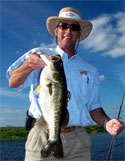 I avoided asking Andy Griffiths the inevitable question for a few hours. But, finally, I broke down and asked him how often he was asked about where Opie was. He laughed and said ‘a lot’.
I avoided asking Andy Griffiths the inevitable question for a few hours. But, finally, I broke down and asked him how often he was asked about where Opie was. He laughed and said ‘a lot’.
After having heard so much about the place, Andy and Bill Smith came to fish the Stick Marsh with us. Bill, from nearby Vero Beach, is a relative of Andy’s, while Andy is out of Key West, FL. In fact, Andy runs a fleet of deep sea charter boats (see his web site at www.fishandy.com).
With just a half-day to work with, we all agreed to do a little with artificials and then go to shiners. We worked the submerged levees and canals, and then we ran shellbeds. A few fish came around to the boat. One small school was located and that made for some fast, but brief, action.
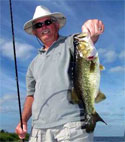 Taking the Blazer down to the south end of Farm 13, we eased around with the depthfinder and finally located an east/west ditch that runs most of the way across the impoundment. This ditch is not on any maps, but shows up on the old Indian River County tax office aerial photos. It can also be located by a grass line that grows on its single small levee on its south side. This grass line is very faint and nearly invisible at most times, but can be seen well when the water is low. Of course, with the recent disappearance of all the grass in the impoundment, you really have to look hard for it. (Super Secret Hint of the Week: the western part of this ditch runs right across the north end of the ‘Nursery’.)
Taking the Blazer down to the south end of Farm 13, we eased around with the depthfinder and finally located an east/west ditch that runs most of the way across the impoundment. This ditch is not on any maps, but shows up on the old Indian River County tax office aerial photos. It can also be located by a grass line that grows on its single small levee on its south side. This grass line is very faint and nearly invisible at most times, but can be seen well when the water is low. Of course, with the recent disappearance of all the grass in the impoundment, you really have to look hard for it. (Super Secret Hint of the Week: the western part of this ditch runs right across the north end of the ‘Nursery’.)
Only one bass came from this ditch location, but it weighed about 5.5 pounds. I suppose that was worth the 20-minute stop. But, we needed some quantities, too. So, we pointed the big boat towards a bit of grass remaining along the eastern shoreline and its paralleling canal.
Setting the shiners out, the action was quick in coming. Our only problem was that we just wished we’d brought more shiners!! The bass stalked and grabbed the shiners on a regular basis, with some running the shiner to the top and blowing the poor baitfish up into the air. Good, quality bass were caught by all.
And, that’s what it’s all about!
November 27, 2004
Happ Harrison and his lovely wife, Deb, came to fish the Stick Marsh with us. The ‘Prime Directive’ was that Deb has a good time.
MISSION ACCOMPLISHED!!
Plus, Happ and I had a good time, too!
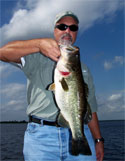 With the artificial bite a bit slow (also called ‘the guide could not find a big concentration of fish’), we decided to go with our wild shiners. We had basically devised a strategy of ½-time artificials and ½-time shiners going in, so we were all prepared for the contingency.
With the artificial bite a bit slow (also called ‘the guide could not find a big concentration of fish’), we decided to go with our wild shiners. We had basically devised a strategy of ½-time artificials and ½-time shiners going in, so we were all prepared for the contingency.
Setting the 202 Pro-V Blazer up parallel tone of the few remaining grasslines in Farm 13, we floated the shiners under bobbers at about 24-inches of depth. I explained that either the action would start slam-bang right away (if the fish were along the edges of the grass) or we would gradually build from slow bite to a very rapid action as the bass gathered.
It is my experience that the fish have some way of detecting other bass feeding. Possibly, it is the sound of the splashing or some other sensing method. Whatever it is, I know that it works. If you are still fishing live bait in the general proximity of an area that is holding bass and you begin to catch some, it appears that the others seem to migrate towards where the action is. The only other explanation I have is that you may be fishing on a god movement route. Then, when a school comes by, they stop and feed on the continual supply of shiners that seem to be magically appearing in front of them. Since most shiner fishing is done on grass lines (disregard the special cases of moving water at spillways), the theory fits, it that grasslines and other ‘edges’ are always movement routes.
But, back to Happ and Deb.
Nearly all women anglers I have fished with, as well as 50% of the men, simply will not set a hook hard. Most times, the bass actually takes care of most of the hooking by refusing to let go of a lure or bait and trying to run with it. When he hits tension on the line, he is usually hooked sufficiently. But, if the single hook of a worm, jig, or shiner rig happens to have its point against a bone of the hard lip area of the bass, the only way to secure an adequate hook-up may be the sharp, firm hookset the angler provides. Nothing is more frustrating than having fish missed due to a ‘wimpy’ hookset. My instructions on hooksetting are usually something like – ‘try to break the rod, turn the boat over, and jerk the fish clean over the boat.’
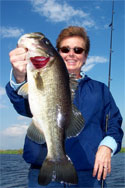 Deb Harrison was an exception to the above situation. At times I though she might actually ‘break the rod, turn the boat over, and jerk the fish clean over the boat’!! This lady was petite, pretty as she could be, and one heck of a fish-snatcher. I mean Deb put the ‘hurt’ on the fish if the got her shiner!
Deb Harrison was an exception to the above situation. At times I though she might actually ‘break the rod, turn the boat over, and jerk the fish clean over the boat’!! This lady was petite, pretty as she could be, and one heck of a fish-snatcher. I mean Deb put the ‘hurt’ on the fish if the got her shiner!
The next great thing was that she really liked this shiner fishing. I am not sure that she had ever done live bait for bass. If she had, it must have few times and not successful. Deb was so excited and intense it started to rub off on Happ and I, too. We were all whooping and hollering every time she hooked into another big Stick Marsh bass. I wish I had the web space for all her pictures, but I can only do her best fish. Numerous others were not far behind it in quality.
Of course, Happ was fishing in the same approximate location, so he was yanking bass, too. And, he did very well. When the shiners in the baitwell started to thin down, Happ insisted that Deb do the fishing with the rest. And, fish that lady did!
Happ and Deb Harrison are the type people who make guiding an enjoyable job.
November 24, 2004
I just met a guy over the telephone a few days ago, but I probably owe him a lot. He was the person who ‘looked after the community’ for a number of the years I have lived here. Paul Rumbley was the Palm Bay Chief of Police and just retired this past July.
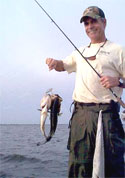 Having taken another job as a school administrative official, Paul is gradually transitioning into soon-to-be full-time retirement. Accordingly, he wanted to talk with me about fishing the Stick Marsh. Since I was finished rigging out our new Blazer 202-ProV and wanted to give it an on-the-water shakedown, I invited Paul to come along. I also advised him to bring a fishing rod, as boating riding was not all we’d do.
Having taken another job as a school administrative official, Paul is gradually transitioning into soon-to-be full-time retirement. Accordingly, he wanted to talk with me about fishing the Stick Marsh. Since I was finished rigging out our new Blazer 202-ProV and wanted to give it an on-the-water shakedown, I invited Paul to come along. I also advised him to bring a fishing rod, as boating riding was not all we’d do.
The Southeast winds were whipping a good 20-MPH when we started out. The first thing we noted was that the 20-foot (+) Blazer took to rough water like a duck. I was very impressed with its ride in the rough chop, as well the fact that it was a dry ride! That ‘dry’ part is really great, especially on a cool day. The big Yamaha 200 engine was quite and smooth as silk, too.
I had added a StingRay hydrofoil fin to the motor to assist getting up on plane quickly, a real necessity with all the submerged wood in our impoundment. This really sounds hard to believe, but the boat went from start to full plane in about 30 feet!! In fact, the rear of the boat never did actually sit down in the water when I applied power. The whole rig just sort of rose up on plane without ever losing its level position. And, all this was with two people and 40(+) gallons of gas onboard. Those fins have always been the first thing I add to my boats. I am a firm believer. It greatly improves hole shot time, low speed planing, significantly reduces chine walk at high speed, and makes steering in turns quick and firm. (Nope, the StingRay folks didn’t provide me the fin; I bought it from Cabelas). You really ought to try one. You never be without it again.
After putting the Blazer through its paces, it appeared everything was just fine, so we went to the east side of the Farm to try and find some windbreak. The ‘windbreak’ we found was called the ‘two-anchor shuffle’. But, two anchors off the front of the boat worked fine and we managed to fish ‘community hole #2’. We didn’t even see a gar roll, much less catch a bass.
Noting that the winds were laying a bit, Paul and I moved out into the Farm to challenge a couple of shell beds. Again, the anchors held OK, but the fish were not present.
With the winds continuing to drop, we moved to one of our ‘Super Secret Hawg Holes’. It took awhile to finally locate the rough area of the submerged levee, but we managed to get close. As we cast around with crank plugs trying to locate the rough section of the levee, Paul made a cast way to our left side.
BANG, BANG – he suddenly had a double on one lure, a sure sign of the presence of a school. That was ‘first’ for Paul, who usually fishes saltwater. This bass fishing looked to him like it could be interesting!!
We both shifted our casts to the left side and began to catch bass on the Rat-L-Trap and Rebel Deep Wee R. I switched off to the Green Pumpkin RIPPIN’ STICK on a Carolina-rig and it was readily gobbled right up, too. We stayed with the location until the school finally ran out.
I think we’ll see more of Paul Rumbley at the Stick Marsh!!
November 23, 2004
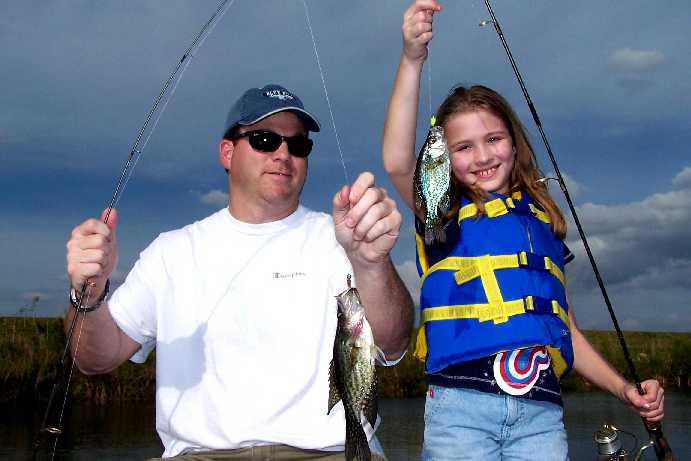 Kids are fun. Especially when they are your grandkids. Our daughter, Lynda, along with husband Mike and daughters Katie and Allie came to visit for Thanksgiving. Katie, the oldest, wanted to go fishing. So, Mike and I took her to the great outdoors. Kids are fun. Especially when they are your grandkids. Our daughter, Lynda, along with husband Mike and daughters Katie and Allie came to visit for Thanksgiving. Katie, the oldest, wanted to go fishing. So, Mike and I took her to the great outdoors.
The first thing we had to do was tech Katie to cast the spinning rig. Since it was an ultra-light outfit, with a small PERFECT Jig, it was not the ideal outfit to learn with. I started to put a heavier lure on, but decided to see how she progressed. Mike and I dodged a few hooks in the process, but the feisty 9-year old finally got the hand of it. In fact, she got pretty good at laying the little jig next to the reeds stands.
Mike decided to toss a jig, or two, himself. So, I just eased along the shoreline and let them fish.
As luck sometimes provides, we somehow came across a school of small crappie. They were ready and willing to chase a PERFECT Jig, so everyone had fun. Dad and Katie even had a double, which really thrilled Katie.
November 22, 2004
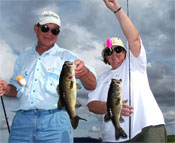 Ted and Diane Cole came down to Lake Wales to visit family and friends over the Thanksgiving holiday. They really wanted to fish that ‘Stick Marsh’ place they had heard so much about. So, we did a little schedule juggling and set them up for a trip. Ted and Diane Cole came down to Lake Wales to visit family and friends over the Thanksgiving holiday. They really wanted to fish that ‘Stick Marsh’ place they had heard so much about. So, we did a little schedule juggling and set them up for a trip.
The Coles like to fish Lake ‘Walk-In-Water’ when the come down. Also know as Lake Weohyalapka, ‘Walk-In-Water’ is nearby to where their relatives live and is quick and easy for them to access. In years past, they have done well on the big lake, which is usually inundated with grass. But, this year, the grass was all gone, thanks to the hurricanes. When I explained what had happened, Ted asked just how to fish the place. I was not much help, in that there is no discernable structure in ‘Walk-In-Water’ and the grass patterns were the only thing anyone ever used to locate fish. It turns out that after our trip to the Stick Marsh, Ted and Diane did find a drop-off area off some reed beds that provided them fish. I’d almost bet there was a rocky or shell bottom there.
But, back to the Stick Marsh trip.
Ted indicated that Diane really like to use a Carolina-rigged worm. That fit our plan to find bass on submerged levees very well, so we started with that.
It was tough fishing. The first three places we worked turned only one small dink. The rest of the locations were not much better. But, we keep hard at it. Finally, in a bit of frustration, I suggested we change tactics completely and go use the two dozen shiners we had brought along.
I really though these two had used shiners a good bit before. But, as it turned out, Diane had never even seen one. And, I am not sure Ted had used them successfully prior to our outing.
We went to the south east corner of Farm 13 and went into the spillway basin. There were three boats already there fishing the barely moving water flow. I saw only one fish caught by those boats in the hour we spent in the basin.
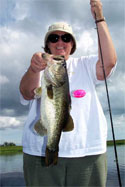 We set up on a section of grass that projects from the levee out over the water. Putting two shiners out next to the grass, I started to sit down and wait for a bite. I didn’t make it, as bobbers started to immediately go down. But, for awhile, they also just came back up. That said we either had chain pickerel, mudfish, or catfish to contend with. It turned out to apparently be two pickerel and, once we caught them, the shiner action quickly became bass!!
We set up on a section of grass that projects from the levee out over the water. Putting two shiners out next to the grass, I started to sit down and wait for a bite. I didn’t make it, as bobbers started to immediately go down. But, for awhile, they also just came back up. That said we either had chain pickerel, mudfish, or catfish to contend with. It turned out to apparently be two pickerel and, once we caught them, the shiner action quickly became bass!!
Diane absolutely went bonkers over this shiner fishing. I’ll bet Ted has to un-retire and get a job in order to by shiners from now on. The gal loved the anticipation of the strike and all the action going on. Of course, Ted was acting ‘cool’, but it was easy to tell that he was getting caught up in it, too.
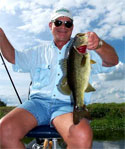 The action was rapid, but the fish mostly just 2- 3 pounds, or so. Then, Diane popped a really good bass. A few minutes later, Ted got one, too.
The action was rapid, but the fish mostly just 2- 3 pounds, or so. Then, Diane popped a really good bass. A few minutes later, Ted got one, too.
Re-baiting the rigs, we set them out on the grass again. Ted’s bobber went down like a shot and then Diane’s deep-sixed, too. So, we had our first double.
A few more fish later, we ran out of shiners and headed back out to hunt bass. This time, we went to the north end of the Farm’s north/south canals. I got directly over the canal and moved slowly along it. Both anglers targeted the submerged levees to the sides, with Ted using a crank plug and Diane her favorite worm rig. Diane put us all to shame as she caught all the fish. It was not that many, but only she landed bass. Even with the pretty good wind blowing, she really has a touch with that Carolina-rig.
Thanks to the shiner action, we wound up having a pretty good day.
November 20, 2004
Our good friend, Walt Hoover had scheduled a crappie trip this day for a fishing buddy and himself. Walt called in to say his friend couldn’t make it, but he still wanted to do the half-day trip. However, he wanted to change to bass. We had just had a great bass trip with Walt a few days before (10 Nov), with Walt getting around 50-60 by himself. It was another one of those big schools we managed to locate that turned the majority of the bass, with 10-15 others coming off some moving water.
This time, however, old Jim’s luck ran dry. We busted it hard for around 6 hours and never found anything but a few singles. We saw no bait fish activity and no breaking fish. Unless you were one of those folks who runs to the spillway at 4:00 AM to get the best seat (when it happens to be running), it appeared to be a really tough day. No one I spoke with had done any good at all, save a couple of guides at the spillway with $15/dozen shiners.
For the last hour, we went behind the ramp area to what we call the ‘back 40’ lot. Walt likes to ‘flip’ in tight on the shoreline and floating vegetation mats and he’s pretty good at it, too. We had three nice solid bass back there in a short period. That says we might do well if we spend a bit of time back there.
I think the day’s total may have been 6 bass. I guess that’s why it’s called ‘fishing’ and not ‘catching’.
November 19, 2004
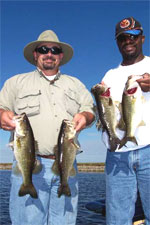 Doug Minor and Ron Felder said to just call them ‘cable guys’. The both work for Adelphia.net down in south Florida and just needed to ‘get away from it all’.
Doug Minor and Ron Felder said to just call them ‘cable guys’. The both work for Adelphia.net down in south Florida and just needed to ‘get away from it all’.
Heck, I think they worked more on our fishing trip than they did back at the job site. Both complained their arms and wrists were tired. Ron even had to just stop, sit down and rest a few times. Fishing really is a tough person’s sport, you know. Especially, when it’s on the fantastic Farm 13/Stick Marsh complex.
Here’s what happened.
We stopped at Super Secret Hawg Hole (SSHH) #2, an old submerged roadbed. We got not even a strike from a gar.
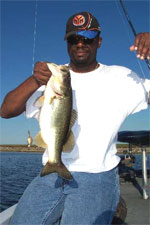 We sped over to SSHH # 5 (a usually-great shell bed) and beat the water to a foamy froth. Bam, Crash it went for 5 bass and then it died. I mean they went on the crank plugs like they were starving. But, there must have been only 5 there at the time. We sped over to SSHH # 5 (a usually-great shell bed) and beat the water to a foamy froth. Bam, Crash it went for 5 bass and then it died. I mean they went on the crank plugs like they were starving. But, there must have been only 5 there at the time.
SSHH #4 (another shell bed or bunch of rocks; can’t tell for sure which) gave the cable guy duo another 5 nice fish. And, as quick as it started, that location to just died.
SSHH #6 (the southern half of a submerged canal) has a LOT of wood in and around it. Stumps and logs are everywhere underwater. I get straddle of the old canal channel and Ron and Doug proceed to dissect the adjacent levees with crank plugs. They got a quick 4 bass in rapid succession. Then, you already know what happened. Same song, 3rd verse.
So, we fired the big Yamaha-powered Blazer 202 Pro-V rig up and it was off to a Community Hole. It is the least-secret fishing spot in the entire impoundment and I’ll bet we were the ‘elebenteenth’ boat to fish it that day.
But, old Jim knows a little special ‘something’ about this spot. While everyone fishes a certain area of this old submerged levee, there is one of those shell beds or rocky areas about a cast and a half away from the Community spot, on the down-sloping side of the levee. Sometimes the bass are there and sometimes they are not.
This time, they were there and with a vengeance, too. It was here that the whoops and yelling over big flying bass gradually gave way to moans of wrists and arms getting tired and comments such as “my thumb’s getting sore and raw”. Ever see a genuine ‘quadruple’?? Look at the pictures.
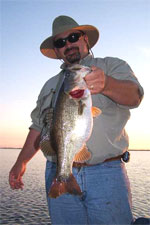 When the crank plug bite started to slow down, I showed the guys how to use a Carolina-rig with a 4-inch RIPPIN” STICK on the hook. The first 5 cast produced as many fish. When the crank plug bite started to slow down, I showed the guys how to use a Carolina-rig with a 4-inch RIPPIN” STICK on the hook. The first 5 cast produced as many fish.
The award for largest bass kept passing back and forth, until just before dark. On his last cast (I already had everything stowed and the anchor up!!), Doug gave a big gal a crank plug and she went all over it. With the setting sun in the background, Doug had her smile once for the camera and then put her back to chase more shiners.
When bass stopped attacking everything that came past them and the surface of the water finally returned to normal, the ‘cable guys’ had boated 40 bass off that single spot, for a total ‘in the boat’ count of 54. Another dozen or so had jumped off before reaching the boat. None were Stick Marsh giants, but a goodly number went 3-4 pounds. It was quality fishing. AND, it did not rely on expensive shiners and a spillway.
November 18, 2004
I get to meet so many really nice people in this fishing business. But, I don’t expect there have been a pair any more enjoyable to be on the water with than Mike and Cindy Smith, from Palm City, FL. Simply outstanding personalities.
After dropping their son off at school in Ft. Pierce, the pair drove up the FL. Turnpike to meet me in Kennansville. (Cindy said their son really likes to fish and was not too happy at being left in front of the school. I can imagine.)
We went over to the east side canal and set up a drift with minnows. A couple of small and we voted to kill that idea.
We went down to the south canal. Again, only a few small ones.
I had found some good fish concentrated in a section of the east canal on the 16th, but we had problems fishing it due to two other boats being there. But, as luck would have it, both eventually moved away enough that we could slip in without bothering them. One left and went further up the canal and the other was fishing for bluegills and anchored on the bank.
Here, we set out about three minnow poles and each of us took up a light spinning outfit with the PERFECT Crappie Jigs attached. Cindy had a new rod and reel set and we put two PERFECT Crappie Jigs about 6 inches apart on her line. Not having fished jigs for crappie before, Cindy was fully open to instruction. After a couple of trials and corrections as to retrieve speed, she got the hang of it and started to land fish. Mike and I had no problem with the jigs and started catching. Of course, the minnows REALLY had no problem and got eaten well. The only problem was that the crappie ran small. A lot were borderline keepers (10 inches), but there were still not the hefty Kennansville crappie we had been catching previously.
After some two hours of fishing this location, the livewell had only 12-15 keepers. I’ll bet we caught 60-70, as they went on the jig nearly every cast. But, the size really left something to be desired.
I guess you just can’t do it every time.
After 4+ hours of fishing, we called it a day and iced the crappie down.
November 16, 2004
Crappie are still great at Kennansville. I was there and found the best concentrations in the south side canal, for a change. While minnows at 5-6 feet were best, I did get a good number to jump on that PERFECT Crappie Jig (chartreuse, w/blue tail). I cast it to the inside (submerged field side) bank of the canal and let it swim down the slope of the drop-off. Like the minnows, most came at around 5 feet.
November 15, 2004
Northeasterly winds of 30-35 MPH shut us down for a couple of days, but we are now back with it. The filming for ESPN was scheduled for Monday, the 15th, but that was the day the winds were worst. So, that was cancelled.
November12, 2004
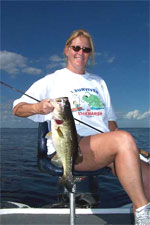 Bass are still spectacular in the Stick Marsh. They are schooled and chasing all the schools of baitfish that roam the place looking for something to hide in. Once you find them, it is a snap to catch 20-40 from each school. Rat-L-Traps (chrome and blue, 1/2 oz.) and RIPPIN' STICK soft jerk baits (weightless and Carolina-rigged, Junebug and Green Pumpkin) have been the most productive lures. Bass are still spectacular in the Stick Marsh. They are schooled and chasing all the schools of baitfish that roam the place looking for something to hide in. Once you find them, it is a snap to catch 20-40 from each school. Rat-L-Traps (chrome and blue, 1/2 oz.) and RIPPIN' STICK soft jerk baits (weightless and Carolina-rigged, Junebug and Green Pumpkin) have been the most productive lures.
Stick Marsh crappie have finally started to bunch up. I had Wendy Cosentino, Palm Bay, out. After catching bass for awhile, Wendy caught a big crappie on her Rat-L-Trap. So, I marked the spot, got out the jigs, and we explored that location. There was no grass or wood and the bottom was flat and bare. Looking around, I saw we were only 30 feet from one of the north/south canals in Farm 13.
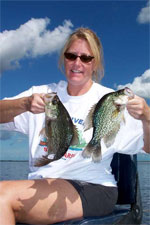 So, I moved to the canal, straddled it and we fishing the jigs slowly along the bottom down in the canal (about 11 feet deep). There they were, but there was still no grass or any type cover present. We brought in a limit, with a couple pushing 1.5 lbs. Most of the crappie had big knots in their bellies and looked like spawners about to lay. We knew that could not be the case, in that the crappie do not spawn here until mid-Feb through the end of March. When I cleaned the fish, we found those knots to be actually be caused by baitfish. All the crappie were absolutely gorged. One of the largest crappie had two shiners in him that were 3 to 3.5 inches long, just about bass bait size.
So, I moved to the canal, straddled it and we fishing the jigs slowly along the bottom down in the canal (about 11 feet deep). There they were, but there was still no grass or any type cover present. We brought in a limit, with a couple pushing 1.5 lbs. Most of the crappie had big knots in their bellies and looked like spawners about to lay. We knew that could not be the case, in that the crappie do not spawn here until mid-Feb through the end of March. When I cleaned the fish, we found those knots to be actually be caused by baitfish. All the crappie were absolutely gorged. One of the largest crappie had two shiners in him that were 3 to 3.5 inches long, just about bass bait size.
It appears the water is cooling some now and the crappie are starting to bunch up tighter in schools. That will make them very competitive for bait and jigs that come by.
November 11, 2004
Appears that our famous easterly winds may be starting early this season. They have been at 25-30 MPH for the past three days, though there appears to be a slacking off down to 20 today. BUT, the bass are just plain going nuts. And, it exactly and precisely as we have been predicting since the last hurricane destroyed all the grass.
Below are some excerpts from past reports and data we posted on the site in the past 6 weeks:
- "Additionally, we stated that, without any grass of significance, the baitfish would move into big, tight schools for protection, resulting in a lot of surface action when the bass run them to the top. That was a strong pattern two weeks ago, died off a bit last week, and then came back strong this week.
- All we have to do is work a submerged canal levee for a short distance and we find bass. Sometimes, they are small. But, most will average a good 2 to 2-1.2 lbs. Once located, these levee bass should be thoroughly worked, as they are nearly all in schools.
- You can often spot their hangouts by seeing them chase hapless baitfish on the surface.
- I think I can say with certainty that concentration on those canals and levees are going to be a sure way to catch a lot of bass. I found four good groups of fish on places I can find again. One school appeared to be tremendously large. Two of the groups of fish cooperated with me by chasing baitfish on the surface and helping me to hone in on them quickly. (Remember, with no grass to hide in, the baitfish are going to get pushed around and to the surface a lot. Watch for them!! )
- ---the only structure of significance was the submerged canals and their levees.
- I would also expect to see a LOT more surface schooling action, in that the poor baitfish have few places to hide now that their grass in non-existent."
We are absolutely catching fish until our arms are tired and our thumbs raw and they are coming off the submerged levees and canals of Farm 13!
Check the recent trip reports below.
November 0, 2004
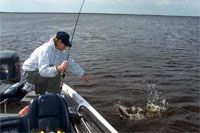 One of our favorite people to fish with, Walt Hoover, called and said he needed a break from work. If you recall, Walt is a grad student working on his doctorate in south Florida. His assignment, for some time now, has been to participate in Alzheimer research center in Boca Raton. It’s an intense, burnout environment and sometimes Walt just has to get up and leave for awhile. Fishing is his rejuvenation method. One of our favorite people to fish with, Walt Hoover, called and said he needed a break from work. If you recall, Walt is a grad student working on his doctorate in south Florida. His assignment, for some time now, has been to participate in Alzheimer research center in Boca Raton. It’s an intense, burnout environment and sometimes Walt just has to get up and leave for awhile. Fishing is his rejuvenation method.
The winds were 25-30 when we launched the big STRATOS rig. But 21 feet of glass boat is nice and safe and rides the swells well. So, we headed for Farm 13. In order to get on the huge schools of bass I had found, we would have to hope two anchors could be lodged on the side of one of the canals sufficiently to hold us in the gale that was blowing.
As usual, I ran a quick check of the spillway gate on the east wall of the Farm. As luck would have it, it was running full tilt. Well, those are sort of ‘gimme’ fish, in that anyone can catch them on that moving water. But, what the hey, our anchors might not hold out in the middle of the Farm. So, we decided to take what we could get.
It was a bass a cast for awhile and then it started to taper off. At that point, two out-of-towner boats from Tennessee came in and tried to anchor. They needed bigger anchors and just got blown away. Holding with the trolling motors a bit, they tried to fish, but I never did see them catch one. Walt continued to catch bass like it was a free beer day and all were celebrating.
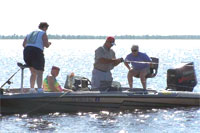 We kept looking for Hugh Crumpler, who was to have his party arrive a couple of hours after Walt and I pulled out. Finally, here he came, the BassCat boat loaded down with ladies. Three of them, in fact. And, Hugh had a well full of shiners, too. I knew what shiners coupled with moving water would do, so I waved him in to anchor beside us. Heck, Walt had already caught more bass than any person should off that spot.
We kept looking for Hugh Crumpler, who was to have his party arrive a couple of hours after Walt and I pulled out. Finally, here he came, the BassCat boat loaded down with ladies. Three of them, in fact. And, Hugh had a well full of shiners, too. I knew what shiners coupled with moving water would do, so I waved him in to anchor beside us. Heck, Walt had already caught more bass than any person should off that spot.
Sure enough, it was only a few moments until the ladies were giggling and smiling and all playing a fish. Poor Hugh looked like that proverbial drunk monkey trying to catch the greasy football. He was baiting hooks, untangling lines, landing bass and performing all the other guide-type services as fast as he could move. It was really great to watch and to see the ladies having such a ball. Walt got so excited with it that he fell off his seat. Thankfully he fell into the floor of the boat and not off the side.
From there, Walt and I ventured out into the center of the Farm, located a canal intersection and then backtracked west along the east/west canal a hundred yards. There was one BIG shellbed here. I got two big river anchors out and dropped them in the deep water of the canal. Sure enough, as soon as they dragged across a way, they caught on the side of the canal and held. I pointed north and told Walt to shoot a crank plug out there – any crank plug.
First cast – BANG! A good bass goes on Walt’s lure.
For three hours we never left that spot (though we did refine our position by 50 feet once). Occasionally, the bass would run some baitfish to the surface and beat them up good. But, they never left the location. In fact, it seemed like more and more must be coming to the levee. In was unreal.
I have no idea how many fish were caught. It was nearly one every cast the whole time. I fished off the upper side of the boat off and on, out of Walt’s way, and I caught them at will, too. Walt finally remarked that he wondered if that school would ever give out. It never did and it must really be huge.
But, that is just about the way things have been going for 6 weeks. Big schools of bass in open water and easy to catch. You just have to locate them.
Bring a map and your depthfinder.
November 8, 2004
I had two really great people in the boat today. David Kuncl and David Heller are a couple of Nationwide Insurance people. They came to Florida in August to work Hurricane Charley for their policyholders who sustained damage.
And, then came Frances.
And, then came Ivan.
And, then came Jeanne.
With luck, these two ‘good guys’ may get to go home in a week, or so. I am sure a lot of storm victims appreciate their being here.
Kuncl called me one night and said he and his friend were just plain tired and needed a day off. He wanted to know if I had an opening and did not even care if they caught a fish. “Just getting out on the water will be enough,” he lamented.
Heck, he didn’t know that he was speaking to the luckiest fisherman in the World (and, Texas). I told him I would make the time for them and assured him they would catch fish. Possibly, the only problem with our day on the water was that neither guy got much rest. The fish just ate them up!!
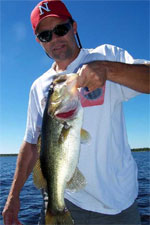 We started out on Super Secret Fishin’ Hole #1 (it’s so secret even I can’t find it sometimes!!). The wind was whipping pretty good, but not overly burdensome. However, it was a 2-anchor day. After working around in a circle a couple of times and peering hard at the depthfinder, I tossed out a marker float. I was satisfied that I had found the old drainage ditch 50 yards off one of the Farm 13’s north/south canals. With no grass lines to use for reference, locating some of these subtle features is difficult. But, once found the first time, you can usually look around and find the top end of an old log that is lodged nearby. In the case of this ditch, there are three logs lying in a neat triangle. One tip of that triangle points right at the ditch.
We started out on Super Secret Fishin’ Hole #1 (it’s so secret even I can’t find it sometimes!!). The wind was whipping pretty good, but not overly burdensome. However, it was a 2-anchor day. After working around in a circle a couple of times and peering hard at the depthfinder, I tossed out a marker float. I was satisfied that I had found the old drainage ditch 50 yards off one of the Farm 13’s north/south canals. With no grass lines to use for reference, locating some of these subtle features is difficult. But, once found the first time, you can usually look around and find the top end of an old log that is lodged nearby. In the case of this ditch, there are three logs lying in a neat triangle. One tip of that triangle points right at the ditch.
I gave the two ‘Davids’ a rod each with a Rat-L-Trap attached. Just to be sure we were in the right place and fish were present, I made a quick cast with a Deep Wee R Rebel to feel the bottom and then feel the lure run off into the open water of the ditch. Of course, being ‘old lucky’, I caught a good bass. That was enough ‘identification’ for me and I told the guys to throw where I had thrown.
Sure enough, the fish were schooled well and jumped on the lures. Kuncl, being in the better position in the boat, had a clear shot right down the center of the ditch and caught one heck of a lot of fish. Heller (also known as ‘HellCat’ to his friends, and a few enemies) finally elbowed Kuncl to one side and got into the proper lure launching path. Then, it got pretty even.
As the fish finally slowed down, I suggested Kuncl try a 5.5-inch unweighted RIPPIN’ STICK and work it slow. The guy was a ‘natural’ with the finesse soft jerk bait. In fact, he was just about as good at fishing it and detecting that subtle strike as anyone I have seen. I lost count of the bass he caught. Meanwhile, I fixed a Carolina-rigged 4-inch RIPPIN’ STICK for Heller. I cast it out once and immediately had a strike, so I passed it to the angler. He caught on (no pun intended) to that lure set-up right away and proceeded to reek havoc with the resident bass population.
As the action cooled (literal translation: ‘they caught so many bass, the fish were either all hooked or they panicked and moved’), we pulled anchor went to Super Secret Fishin’ Hole #6. It was close by, so I figured to at least give it a shot.
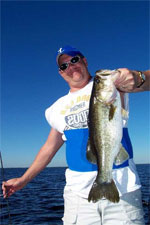 I think we were the ones that got ‘shot’. Shot by a zillion bass chasing baitfish across a big shellbed!! Again, the same lures did the job and the bass were ready and willing. It took awhile for these fish to slow down. But, when they did, we opted to spend our last hour back at Super Secret Fishin’ Hole #1 with a dozen shiners we had brought as back-up.
I think we were the ones that got ‘shot’. Shot by a zillion bass chasing baitfish across a big shellbed!! Again, the same lures did the job and the bass were ready and willing. It took awhile for these fish to slow down. But, when they did, we opted to spend our last hour back at Super Secret Fishin’ Hole #1 with a dozen shiners we had brought as back-up.
As we anchored on Super Secret Fishin’ Hole #1, I saw a couple of baitfish go flying across the surface. So, as any decent guide would do, I heaved a pair of shiners to the vicinity. The first shiner got blown up into the air and the bass caught him coming back down. The rest just grabbed them and ran.
Both anglers were very adamant that the day produced more and larger bass than either had ever taken on a fishing trip. Kuncl noted that their Nebraska bass just don’t get a full-bodied nor as big as the Stick Marsh fish. I explained that our growing season is 365 days a year, with virtually no really cold days. So, the bass just eat and grow year-round in the food chain-rich Stick Marsh waters.
For all the bass caught this day, we are seeing a pattern start on the size of the bass. These school fish we keep catching and catching, trip after trip, are running 2.5 to 4-lbs. occasionally, we hit one 5-lbs, or slightly better.
But, the obvious issue is that there are no giants being hooked. That tells me that the really big bass are still down in the little cover left in the impoundment. That is wood. And, that may be hard. We have to make some decisions – take 50-80 bass a day in the medium size class, or go for just a few bass in the submerged wood in hopes of a ‘biggie’. That’s a tough decision to make. Personally, I like the continuous action of the smaller school fish (‘smaller’ being 2.5 to 4-lbs, with some in the 5-6 lb. range) that run the structure features in huge schools. But, each angler has to decide.
November 6, 2004
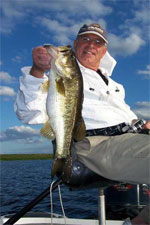 Jack Tebac is an interesting guy. He is a practicing minister, as well as a marketer in the business World. In preparation for retirement, Jack has moved his family to Florida. But, he makes a weekly flight back to Long Island, NY, to preach the Gospel. Jack Tebac is an interesting guy. He is a practicing minister, as well as a marketer in the business World. In preparation for retirement, Jack has moved his family to Florida. But, he makes a weekly flight back to Long Island, NY, to preach the Gospel.
After he and his son Daniel got ‘baptized’ by the Stick Marsh fish, I expect he may be looking for a place to conduct services in Florida!
Daniel is 13 years old, but he’s going on 36 in the fishing department. The boy is pretty good now and may be a real pro as he gets to be an adult. Jack ain’t the World’s Worst, either. He handles that equipment like he knows what it’s for.
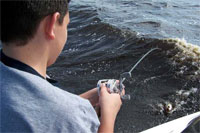 Per the recent weather pattern, the winds came at us pretty strong and the waters of Farm 13 rolled right on along. If you take a look over Daniel’s shoulder in one picture, you’ll see a fish and a LOT of big waves. Once again, a 2-anchor day. But, once again, the ‘Old Lucky’ guide managed to pick some good spots.
Per the recent weather pattern, the winds came at us pretty strong and the waters of Farm 13 rolled right on along. If you take a look over Daniel’s shoulder in one picture, you’ll see a fish and a LOT of big waves. Once again, a 2-anchor day. But, once again, the ‘Old Lucky’ guide managed to pick some good spots.
Jack and Daniel got an introduction to Rat-L-Traps and Carolina-rigged RIPPIN’ STICKS. The bass did their thing and a lot of fish came aboard.
We had two dozen shiners in the well as a contingency against really bad winds. So, I suggested we go and set them out and not waste any. This year, shiners appear to be priced as though they are gold plated. Try $15.00/dozen. I am avoiding them like the plague, except for the small contingency number. You should, too. You can catch more bass in a given period of time with artificials anyway. If we boycott them a bit, the price will come down.
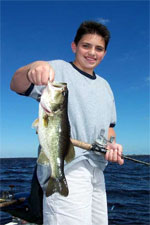 We set out to the southern part of the Farm. But, we did not go for the moving water at the spillway. Instead, we went for Super Secret Fishin’ Hole #2. This is a sunken barge, still full of rock and whatever. It is about 6 feet under water at its shallowest point, and has a bit of grass growing on it. The bass love the darn place, as Jack and Daniel soon found out.
We set out to the southern part of the Farm. But, we did not go for the moving water at the spillway. Instead, we went for Super Secret Fishin’ Hole #2. This is a sunken barge, still full of rock and whatever. It is about 6 feet under water at its shallowest point, and has a bit of grass growing on it. The bass love the darn place, as Jack and Daniel soon found out.
Playing an angler with the wind to keep the shiners blown in over our target, we soon started catching fish. At first they were small. Then, the size improved dramatically. Shiners were hitting the surface, looking for a ladder to climb to get away from the charging bass! Finally, Daniel hit what may have been a real giant bass, only to have it pull him up out of his seat and his rod over into the water. Then, it just bulled its way back under the grass mat and got hung up. From what I saw, it was just too big a fish for Daniel’s smaller frame to handle. 2.5 to 4-lbs
Jack indicated it was more bass and larger bass than they had ever caught. That’s always a good result from a guide trip!
If the winds persist, I may suggest that some clients reschedule their trips next week. It is just not acceptable to pay big bucks to fish and have at least a decent shot at catching. I, personally, don’t like to take money for that type of trip. So, we’ll see what transpires and let you know soon.
November 5, 2004
Boy, it has been good week. We only took out three parties, but that was by design. Too many things to plan/do:
- We needed the time off to do some exploring on the ‘new’ Stick Marsh.
- e are getting new boat sponsors in BLAZER Boats and Yamaha outboards (www.blazerboats.com/) and that had some coordination to be finalized.
- We are going to shoot Sportsman’s Challenge TV show (an ESPN element) on the Stick Marsh on 15 November and needed to get that little ditty in line. Additionally, we wanted to get the new Blazer wrung out in time to use it for the taping.
- ESPN asked to do a sidebar segment on the Skeeter Hawk restoration project (www.stickmarsh.com/skeeter/), as well, so we’ll have to clean her up and get the fish scales off!
November is really shaping up as a ‘never sit down and rest’ month!!
If you have been keeping up with our ramblings about the post- hurricane Stick Marsh and its ‘grass-less’ environment, you know what we have predicted will happen with the fish and even where they will most probably be found. I have to say now, some 6 weeks later, that the predictions appear to exactly on track.
- Wood
- Any significant bottom contour changes (structure)
- A combination of the two
These were expected to be the key elements to hold the baitfish and, therefore, the bass. And, they are undoubtedly the answer.
Additionally, we stated that, without any grass of significance, the baitfish would move into big, tight schools for protection, resulting in a lot of surface action when the bass run them to the top. That was a strong pattern two weeks ago, died off a bit last week, and then came back strong this week. On a calm day and a smooth surface, you can see the huge baitfish pods all over the western half of the Stick Marsh and the northern section of Farm 13. This surface feeding will possibly be really strong after the bass finish their spawn mid-December through February and start looking for groceries, instead of love, again.
All we have to do is work a submerged canal levee for a short distance and we find bass. Sometimes, they are small. But, most will average a good 2 to 2-1.2 lbs. Once located, these levee bass should be thoroughly worked, as they are nearly all in schools.
The wood in the Stick Marsh has got them, too. See one of the report segments below for details.
The best location for both quantities and size of bass has been the south end of Farm 13. All of the submerged canals down there have varying degrees of old timber remains. Find the right one and its gangbusters. Plus, the open areas between the canals down there are also full of wood. You really don’t need the canal, itself. Just drift and cast until you hit fish. Then, toss a marker out and start to circle the area until you locate the prime holding location. These fish average a bit better than 3 lbs.
As for lures, Traps, shallow cranks and Carolina-rig RIPPIN’ STICKS work great on the levees. Down in the wood, use the same hard-bodied lures, but go to a weightless RIPPIN’ STICK and work it ‘slow pull and drop, etc’.
November 4, 2004
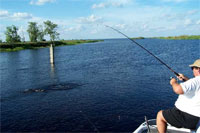 This day found us out all day with Bob Polce and his home builder/remodeler, Rocky. These guys were both originally from Pennsylvania and not quite used to the size bass the Stick Marsh habitually produces. They got a good dose of ‘getting fished’, both with the crank plugs on the levees and wood, as well as with those live wild shiners. This day found us out all day with Bob Polce and his home builder/remodeler, Rocky. These guys were both originally from Pennsylvania and not quite used to the size bass the Stick Marsh habitually produces. They got a good dose of ‘getting fished’, both with the crank plugs on the levees and wood, as well as with those live wild shiners.
Our first location was a shellbed right out in the middle of the Farm 13 side. We could almost cast and hit the buoy (hint, hint) that marks the geographical center of the Farm (that’s where they do the water quality testing). I gave the boys a Rat-L-Trap apiece and then set out a fat shiner right where I thought the shell bed was. That bobber went down so hard and suddenly, we could actually hear it pop.
Bob grabbed the rod and brought in the first bass of the day, a good 3.5 lber. But, for some reason, that was the last bass we got to even bite at a shiner until that afternoon. It was strange, because the Traps hauled in fish after fish from the same location.
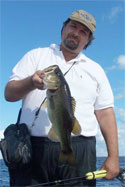 When we burned that bass school up, our party moved a few hundred yards to another hard-bottom location. I can’t tell for sure if the spot has shells or possibly rock. It sure is a rough dickens, though. I put out a shiner and Bob and Rocky commenced to chunk the Traps. Dang --- Traps and bass were turning cartwheels all around the bobber and that shiner. But, the shiner must have forgotten to use his Right Guard that morning, as the bass would not even give him a sniff. When we burned that bass school up, our party moved a few hundred yards to another hard-bottom location. I can’t tell for sure if the spot has shells or possibly rock. It sure is a rough dickens, though. I put out a shiner and Bob and Rocky commenced to chunk the Traps. Dang --- Traps and bass were turning cartwheels all around the bobber and that shiner. But, the shiner must have forgotten to use his Right Guard that morning, as the bass would not even give him a sniff.
We burned those fish up and the total was now around ‘Fishermen 22/bass 5’ (caught/got off). Things were shaping up for a good fishing day. I sure was glad, as Bob and Rocky had driven up from south Florida that morning and that’s a long, tiring haul!
Our 3rd spot was down in the south end of the Farm. I could see George and Scott Welcome and a 3rd party in Scott’s boat off to the west. They were doing what I do on days off and that is isolating the vast waters down to where the fish are located (they are pretty darned good at it, too!)
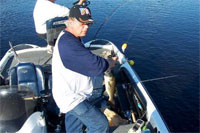 Switching Rocky to a Firetiger mid-sized Big-O crank plug and leaving Bob with the Trap, we laid out a course paralleling a submerged canal. Rather than straddling the canal, I stayed to the west side of it and we cast the lures all the way across the canal and both levees. There was a LOT of wood down there and we did get hung a few times. But, we caught some nice bass there, with Rocky getting a good one right off on the Big O. There were two on which appeared to be 5-lbs. (+), but both pull off before we got them to the boat. Switching Rocky to a Firetiger mid-sized Big-O crank plug and leaving Bob with the Trap, we laid out a course paralleling a submerged canal. Rather than straddling the canal, I stayed to the west side of it and we cast the lures all the way across the canal and both levees. There was a LOT of wood down there and we did get hung a few times. But, we caught some nice bass there, with Rocky getting a good one right off on the Big O. There were two on which appeared to be 5-lbs. (+), but both pull off before we got them to the boat.
After a few successful passes up and down this selected area, we counted up the fish and decided to go burn up a few shiners before the heat got to them. The fishing was good and count was rising!
Much to my usual avoidance of the spillway areas, I must admit that I went into the southeast corner of the Farm and its gate. I had watched from the Farm earlier as 3-4 boat left that location, so I assumed the water was not running. Actually, it was slowly seeping, with just enough current to show movement. You normally can’t catch a bass on an artificial when it is like that. BUT, there is one small place where shiners and a Carolina-rigged 4-inch Junebug RIPPIN’ STICK will do them harm. It is a very specific place that is small and compact. It has to be addressed from a certain direction to take advantage of the available current and a big bunch of what appear to be shells and rocks. It is too far away from the gate to be riprap, so we guess it is shell/rock. Maybe I will get to ask a fish someday and find out for sure. Whatever the case, the bass were right in that little area and we got right on them.
As luck would have it, two vehicles and three airboats suddenly arrived, spewing forth all sorts of folks in various forms of outdoor wear and carrying a multitude of cameras and other gear. We discussed if it was PETA coming to film us hurting all those fish. Turned out to be some sort of film for Public Television or a St. Johns Water management District spot. They were only 50 feet from us and we heard all the discussion on water quality and the Stick Marsh impoundment functions. Without them asking, we kept as quiet as the big bass would let us. But, once in awhile, someone did let out a whoop as a big ‘um came flying to the surface. The bass were eating us alive and most everyone except the gal doing the talking was watching us. Even the guy doing the filming was watching Bob and Rocky catch fish. I know the background sounds of that film will be interesting. Probably sounds like a herd of cows in the water. While the others left the area for the airboats, the guy doing the filming stayed in place and put his camera on the fishing. I said we had been having a good day. He smiled and replied, “I can darn well see that!”.
Now, we is movie stars, boys! Which one of you’ns can write so we can giver out autygraphs?
November 3, 2004
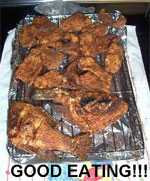 I kinda like catching crappie. It is easy, once you find the critters. Plus, they sure do make great table fare. Here’s a good site with good recipes (www.crappie.com/recipe/all.html). My cookbook also has a few good ones, too. I kinda like catching crappie. It is easy, once you find the critters. Plus, they sure do make great table fare. Here’s a good site with good recipes (www.crappie.com/recipe/all.html). My cookbook also has a few good ones, too.
But, I digress.
The wife said that everyone gets to go catch those big Kennansville crappie, but her. I ain’t no dummy, no matter what my first wife says. So, I took Dot to the pond.
I wish Kennansville wasn’t so far. It cuts into the fishing day too much. BUT, so far, we have managed to get two limits every time in four hours or less. Now, that counts the smaller throw-backs, which we later substituted bigger crappie for. I expect we average 70-80 fish in a full day. I know Wayne Winters and I brought back 48 for the freezer last week .See the report at (www.stickmarsh.com/stickmarsh/reports/oct2004.shtml). But, we sure caught a LOT more.
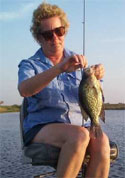 Anyway, I am somewhat fished out. So, I watch Dot catch fish. I played like a good guide and took the crappie off the hook, tossed them into the livewell and re-baited hooks. Listen, folks, I have a wife whom both kids and fish just love. They both come to that woman with arms (fins?) outstretched. I stayed fished out until she started getting those 1.5 and 2.0 lb. fish. I kinda got interested then. Anyway, I am somewhat fished out. So, I watch Dot catch fish. I played like a good guide and took the crappie off the hook, tossed them into the livewell and re-baited hooks. Listen, folks, I have a wife whom both kids and fish just love. They both come to that woman with arms (fins?) outstretched. I stayed fished out until she started getting those 1.5 and 2.0 lb. fish. I kinda got interested then.
It was the same story/second verse type of thing. We caught a bunch. Kennansville is good to you, if you know where and how. Boat control is awfully important, for speed and positioning. Of course, guess who has to clean them. The definition of REAL fisherman’s luck is having a wife who will clean them. I am not too lucky in that respect. But, an electric knife sure is good stuff!! (www.jimporter.org/articles/article107.shtml).
November 1, 2004
Well, I have a $50 fishing trip deposit in my pocket and no fisherman to show for it. I waited at the ramp for 2 hrs. and Gary Clark was a no-show. He was driving from Sarasota. I hope nothing happened. If you are out there Gary, contact me. Your tel.# comes back void now. Hope you didn’t get tangled up with my ex-wife.
So, I went fishing. I found three new places on those long submerged levees in the Farm that seemed to hold bass. I will find out next Thursday when Bob Polce comes to town. We’ll try those first, as probably no one has fished them. It is hard to find those really good spots, unless you live close by and get to fish the place a lot.
I am somewhat lucky to live close by and get to fish the place a lot!

Today's Weather for
the Stick Marsh Area
Past Stick Marsh Fishing Reports
Farm 13 / Stick Marsh Information Guide
Email questions to jporter@jimporter.org.
|
Recommended sites by The Fishin' Tipster |
A common question that we get: "Is there somewhere close to get bait and tackle?" This is where we get our bait.

Pete and Tina Heinz / 9 South Mulberry St. / Fellsmere, FL 32948 / 772-571-9855
Get your site listed here
Let us help you drive more targeted traffic to your site.
|


Rank our Site
©Copyright 2001-07 All rights reserved by Jim Porter, any reproduction, quotation or other use of this site or its elements is prohibited without the express written permission of Jim Porter
|
|


 FROGG TOGGS RAIN GEAR
FROGG TOGGS RAIN GEAR
THE BEST PRICES AVAILABLE!!


|
|







